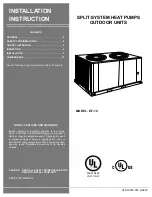
035-18550-001-A-0902
Unitary Products Group
13
Schrader access valves are provided on the compres-
sor vapor and discharge lines for pressure checking
the system.
All access ports are sealed with a removable cap.
Never remove a cap unless the valve is fully back-
seated with its valve stem in the maximum counter-
clockwise position because the refrigerant charge will
be lost.
EXTENDING THE SERVICE PORTS
Refer to Figure 7:
1.
Loosen the screws securing the service ports in
shipping position. (See Figure 7).
2.
Push the service ports through the corner post.
3.
Tighten the screws to secure the service ports for
installation.
INSTALLATION
Since the condensing units are shipped with a holding
charge of refrigerant-22, they can be checked for a
refrigerant leak by depressing the stem on either of the
service ports that extend through the cabinet. As soon
as some internal pressure is relieved release the stem.
DO NOT release the entire holding charge.
If the unit has already lost its holding charge, it should
be leak tested and the necessary repairs should be
made. If the unit has maintained its holding charge, you
can assume that it has no leaks and proceed with the
installation.
Before installing the liquid line between the outdoor
and indoor units, remove the copper disc from the liq-
uid connection on the outdoor unit per the following
procedure:
1.
Make sure the refrigerant in the line has been
recovered and that the liquid service valve on the
unit is front-seated and closed. The valve stem
should be turned to its maximum clockwise posi-
tion.
2.
Drill a small hole through the disc before unbrazing
it to permit a flow of dry nitrogen through the con-
nection while it is being unbrazed.
3.
Remove the cap from the 1/4" access port on the
liquid line stop valve.
4.
Connect a supply of dry nitrogen to this access
port.
5.
Unbraze the copper disc from the liquid connection
while maintaining a minimum flow of dry nitrogen
through the connection.
6.
Burnish the external surfaces of the liquid connec-
tion on the outdoor unit and the end of the field-
supplied piping being used for the liquid line.
NOTE:
Clean surfaces are essential for a well brazed
connection.
7.
Carefully clean the internal surfaces of the above.
Any particles left on these surfaces may lead to a
future system malfunction.
NOTE:
Use only copper tubing that has been espe-
cially cleaned and dehydrated for refrigerant
use. If the tubing has been open for an
When making a braze connection, wrap a wet
rag around all tubing inside the unit to prevent
damage to the other components.
Dry nitrogen should always be supplied
through a connection while it is being brazed or
unbrazed because the temperature required to
make or break a brazed joint is sufficiently high
to cause oxidation of the copper unless an inert
atmosphere is provided. The flow of nitrogen
should be continued until the joint has cooled.
The dry nitrogen must always be supplied
through a pressure regulating valve.
This hole is also required to prevent the inter-
nal pressure from building up as the disc is
being unbrazed and from blowing the disc off.
This warning applies to any disc being
removed from a service valve, coil connection,
etc.
























